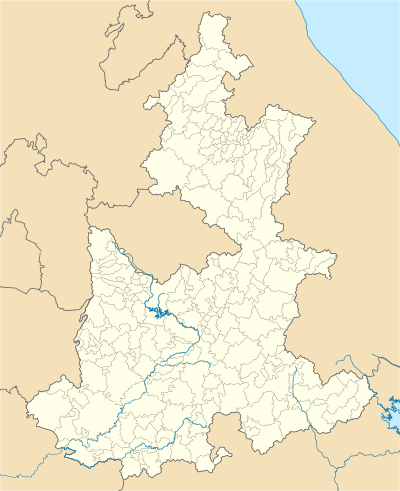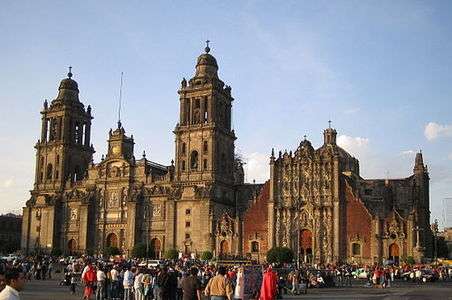Puebla Cathedral
Puebla Cathedral is a Roman Catholic church in the city of Puebla's historic centre, in the state of Puebla, Mexico. It is a colonial cathedral, and is the see of the Roman Catholic Archdiocese of Puebla de los Ángeles. The cathedral's archbishop is Víctor Sánchez Espinosa. The cathedral is dedicated to the Immaculate Conception.[1]
| Puebla Cathedral | |
|---|---|
| Cathedral Basilica of the Immaculate Conception | |
Basílica Catedral Metropolitana de Nuestra Señora de la Purísima Concepción | |
Puebla Cathedral | |
 Puebla Cathedral Location in the state of Puebla | |
| 19°2′34.20″N 98°11′54.10″W | |
| Location | Historic centre of Puebla |
| Country | Mexico |
| Denomination | Roman Catholic |
| Website | arquidiocesisdepuebla |
| History | |
| Status | Cathedral, minor basilica |
| Architecture | |
| Functional status | Active |
| Heritage designation | World Heritage Site |
| Architect(s) | Francisco Becerra |
| Style | Baroque |
| Groundbreaking | 1575 |
| Completed | 1690 |
| Administration | |
| Archdiocese | Puebla de los Ángeles |
| Clergy | |
| Archbishop | Victor Sánchez Espinosa |
History
On January 24, 1557 Viceroy Martín Enríquez (1562–80) authorized construction. The design was submitted to the Dean and Cathedral Chapter on November 11, 1557.[2] Construction began in November 1575, under the direction of architect Francisco Becerra and Juan de Cigorondo. Construction was interrupted in 1626 but in 1634 Juan Gómez de Trasmonte modified the design and construction began again in 1640 when Bishop Juan de Palafox y Mendoza arrived with the appointment of visitor-general of New Spain and bishop of Puebla. The cathedral was in bad shape when Palafox arrived in 1640, the building not yet completed and unconsecrated. When Palafox lost his struggle with the Jesuits and viceroy Salvatierra, he was appointed bishop to a minor diocese in Spain, but before he left New Spain in 1649 he devoted considerable energy to completing the cathedral and its consecration. The renovation over nine years had cost 350,000 pesos, engaged 1,500 workers under the supervision of an Aragonese Pedro García Ferrer. The ceremony of consecration was set for April 18, 1649, and for Palafox was not only the culmination of the massive building project, but also his grand farewell to his diocese.[3] The Cathedral was consecrated to the Virgin Mary in a huge and emotional ceremony, with civil and religious participants, the reburial of the remains of previous prelates, brilliant musical performances, and a sermon by Palafox himself in his final farewell to his flock.[4] It was not entirely completed until 1690. The front façade was built out of a black limestone, and it has two towers, the tallest in Mexico,[1] one of which has no bells. According to legend, an underground river passes under that tower and if bells were placed in it, the tower would collapse.
Interior
The interior of the cathedral contains many artistic artifacts that are found in its 14 lateral chapels and the main altar. Its principal altar is referred to as "The Major Altar", or "The Altar of the Kings", which was designed by Manuel Tolsa and built between 1797 and 1818. Some bishops of Puebla are buried under it. Across most of the rear wall of the cathedral is a Blessed Sacrament chapel.[1] The inside of the dome of the apse chapel was painted with The Assumption of the Virgin by Cristóbal de Villalpando.[5]
Music
The cathedral in Puebla had a distinguished musical tradition, dating from the late sixteenth century.[6][7] One of the most distinguished musicians was Juan Gutiérrez de Padilla, active as chapel master from 1629 to 1664. His wrote extended and complex works, including polychoral masses as well as villancicos (for the Christmas season). His music shows the evidence of New Spain's non-white population in tocotines (Nahua influence) and negrillos and porto ricos (African influence). The Cathedral has extant choir books of his compositions. His villancicos "stand as one of the greatest contributions to American music history."[8]
Gallery
- Facade of the Puebla Cathedral
- Rear view
- Fountain and belltowers
- November 20, 2010, inauguration of the new lighting system
- Lateral entrance
 Interior of the Cathedral
Interior of the Cathedral Ceiling painting in the cathedral
Ceiling painting in the cathedral- Second organ
See also
References
- Crowe, Gretchen R. (2006-12-14). "City of Puebla Shines as Mexican 'Jewel'". Catholic Herald. Retrieved 2010-12-02.
- Leicht, Hugo (1934). Las Calles de Puebla (2002 ed.). Puebla Pue. México: Secretaría de Cultura/Gobierno del Estado de Puebla. p. 142. ISBN 968-5122-54-7.
- Cayetana Alvarez de Toledo, Politics and Reform in Spain and Viceregal Mexico: the Life and Thought of Juan de Palafox 1600-1659 Oxford: Clarendon Press 2004, p. 257.
- Alvarez de Toledo, ibid., p. 258.
- Haces, Juana Gutierrez (2006) "Cristobal de Vallalpando" page 535 In Rishel, Joseph J. and Stratton-Pruitt, Suzanne (editors) (2006) The Arts in Latin America, 1492–1820 Yale University Press, New Haven, Connecticut, ISBN 978-0-300-12003-5
- Alice Ray Catalyne, "Music of the Sixteenth to Eighteenth Centuries in the Cathedral of Puebla, Mexico." Yearbook of the Inter-American Institute for Musical Research 2 (1966).
- Robert M. Stevenson, "Puebla chapelmasters and Organists: sixteenth and seventeenth centuries." Part I. Inter-American Music Review 5:2 (Spring-Summer 1983) and Part 2, Inter-American Music Review 6:1 (Fall 1984).
- Craig H. Russell, "Music: Mesoamerica through seventeenth century", Encyclopedia of Mexico, Michael S. Werner, editor. Chicago: Fitzroy Dearborn Publishers 1997, volume 2, p.977.
External links
| Wikimedia Commons has media related to Cathedral of Puebla. |
